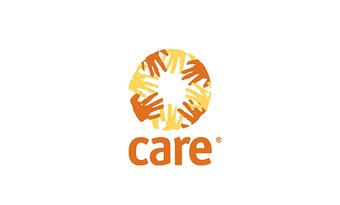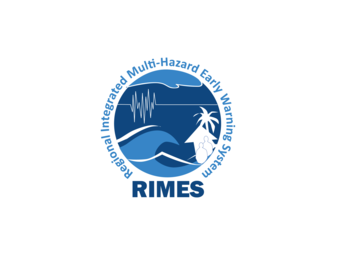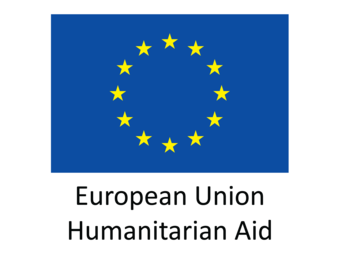Categories
Supporting Flood Forecast-Based Action and Learning in Bangladesh (SUFAL): Phase I and Phase II
The SUFAL project worked with communities, government institutions and local disaster management committees to build on existing capacity and support the implementation of community-focused, forecast-based actions to mitigate the potential impacts of monsoon floods in Bangladesh’s northwest region. It focused on integrating anticipatory action into Bangladesh’s national disaster-risk management framework by: (1) improving access to local impact-based forecasts and early warnings; (2) identifying thresholds and setting triggers for early action; (3) testing appropriate early actions that address the needs and priorities of vulnerable communities; and (4) generating evidence and lessons to influence policy, plans and financing for anticipatory action.
After the successful completion of the first phase, the second phase focusing on consolidating learning and scaling up forecast-based financing and forecast-based action (FbA/FbF) started on 1 July 2021 and will continue until September 2024.
The SUFAL-II project continues to support the Bangladesh government in developing a community-based approach to forecast-based action in monsoon flood-prone north-western Char areas, and in flash flood and lightning prone north-eastern Haor areas. The results of the action are structured around the three pillars of anticipatory action:
- Enhanced Early Warning System with tailored forecast information are available and used by the stakeholders and community.
- Institutions and communities are able to take timely, appropriate, inclusive and sector specific early actions to respond to multi-hazards.
- Standard Operating Procedures (SOP) / Early Action Protocols (EAP) and financing mechanisms are developed through evidence generation and advocacy.
The SUFAL-II consortium is managed by CARE Deutschland e.V. and implemented by CARE Bangladesh as the lead agency. Partners are Concern Worldwide and their local partners ESDO and People’s Oriented Program Implementation (POPI) (CARE) and the SKS Foundation and Friends In Village Development Bangladesh (FIVDB) (CWW), and the Regional Integrated Multi-Hazard Early Warning System (RIMES). The project is supported financially by the European Civil Protection and Humanitarian Aid Operations (ECHO) and Aktion Deutschland Hilft (ADH). CARE UK provides technical support in project implementation.
Start/end date
Phase 1: August 2019 – June 2021
Phase 2: July 2021 – September 2024
Hazards covered
Monsoon floods, Flash floods, Lightning
Regions covered
Phase I: Kurigram, Gaibandha and Jamalpur districts of northern Bangladesh
Phase II: Kurigram, Gaibandha, Jamalpur and Bogura districts of north-western, and Sylhet, Sunamganj and Netrokona districts of north-eastern Bangladesh
Early action sectors
Agriculture | Livestock | Water, sanitation and hygiene (WASH) | Health and water-borne diseases | Evacuation | Shelter | Social protection (cash) | Gender and inclusion
Anticipatory action protocols/plans in place
Early Action Matrix for Monsoon flood
Activations
2020 monsoon
Population reached during activation
During the 2020 monsoon, SUFAL supported 100,000 people with community-based early actions
Key actors / implementing partners
Ministry of Disaster Management and Relief, Department of Disaster Management | Bangladesh Meteorological Department | Bangladesh Water Development Board, Flood Forecast and Warning Center | Inter-ministerial National Taskforce on FbF/FbA | Local disaster management committees
Project description
To increase the resilience of communities in northern Bangladesh to the impacts of monsoon flooding through forecast-based action for disaster risk reduction, SUFAL project started working with government institutions, local disaster management committees, and communities from 2019. In its first phase from August 2019 to June 2021, SUFAL focused on: (1) improving access to local impact-based forecasts and early warnings; (2) identifying thresholds and setting triggers for early action; (3) testing appropriate early actions that address the needs and priorities of vulnerable communities; and (4) generating evidence and lessons to influence policy, plans and financing for anticipatory action.
With the lessons from phase I, phase II of SUFAL is starting from July 2021, by expanding its action in northwest for monsoon flood with a more community-based anticipatory action approach with a focus on developing the capacity of communities and the most vulnerable households to take early actions. The early action matrix developed in SUFAL-I has been shared, reviewed, and refined in consultation with the National Taskforce, the Department of Disaster Management, the Flood Forecast and Warning Center, and other stakeholders by scaling up into the agriculture, livestock, WASH, and health (e.g., water-borne diseases, COVID-19) sectors and to test gender-responsive and inclusive early actions. It continues working with the Flood Forecast and Warning Center to strengthen its capacity, focusing on the generation of localized forecasts and longer lead times. The project also works with end-users to ensure the information they need for decision-making is made available in time.
The government of Bangladesh adopted its revised Standing Order on Disasters (SOD 2019), which includes a National Taskforce on Forecast-based Financing / Action (FbF/A). This is coordinated by the Ministry of Disaster Management and Relief and the Department of Disaster Management and is responsible for: (1) providing guidance on FbA-related strategies (e.g., risk, triggers) to coordinate FbF/FbA for various disasters; (2) the release of funds; and (3) preparing protocols and/or guidelines with roles and responsibilities. To support the government in integrating the FbA approach, phase II of the SUFAL project is continuing national-level discussions on triggers, protocols, early actions, and financing mechanisms for monsoon flooding in the northwest region of Bangladesh. From the financing mechanism identified in the first phase, SUFAL II aims to generate evidence from ground mapping and pilot to link forecast-based actions and social safety net programs to test the possibility of supporting the most vulnerable households through existing social protection schemes and channels ahead of anticipated floods. It further emphasizes on development of guidelines for the utilization of district disaster management fund linked to triggers.
SUFAL II is further scaling up its action on flash flood and lightning in north-eastern Haor areas to enhance capacity of the institutions and community to implement Forecast-based Action (FbA). Along with Flood Forecasting and Warning Centre to strengthen monsoon and flash flood forecast, the project will also work with Bangladesh Meteorological Department for real-time lightning alert awareness. It will keep up the community-based approach for local government and communities to take sector specific, gender-inclusive early action. With timely, accurate and actionable forecasts, SUFAL will support community and institutions to act ahead of monsoon flood, flash flood and lightning with pre-arranged finance and resources.

After receiving 4,500 Bangladeshi Taka from SUFAL, my family could immediately move to a relative’s house by hiring a boat.
Outcomes and lessons learned
SUFAL Phase I
- Over 100,000 people supported with timely and localized early-warning information and community-based early actions, implemented through local disaster management committees.
- At the community level, shelter renovations encouraged communities to evacuate earlier. More households moved their livestock to cattle sheds, and cash for work schemes provided employment and the cash needed to protect livelihoods and assets, while maintaining communication.
- According to a post-monsoon assessment of the 2020 floods, 58 per cent of respondents were financially able to take early actions, and 36 per cent of respondents needed partial support. Average savings per household were 19,161 Bangladeshi Taka (BDT) in household assets, 36,552 BDT in livestock, and 23,451 BDT in fisheries.
- According to the evaluation report, 97 per cent of the 39,729 households in the targeted unions received early-warning messages through community volunteers, loudspeaker announcements and individual information-dissemination processes in 2020. In addition, 8,800 individuals in disaster management committees and communities directly received regular flood forecasts, early warnings and advisories through voice messages. About 63-80 per cent of early-warning recipients took immediate early actions three to five days before the flood. Women were more responsive in terms of taking early actions and sharing early warnings.
- The Flood Forecasting and Warning Centre developed and adopted impact-based forecasts and vulnerability mapping, and generated 15-day outlooks for the flood in 2020.
- Community-based early-action plans and triggers for disaster management committees were produced for the 2020 monsoon and adopted for 2021.
- The National Taskforce on FbF/FbA began joint advocacy efforts with Red Cross Red Crescent societies, United Nations agencies and the Start Network.
SUFAL Phase II
- Impact-based forecasts generated for the 8 unions which are continuing from SUFAL. By overlaying the vulnerability map and inundation map, risk map for those unions has been developed for 2022 monsoon season to support local institutions and Disaster Management Committees for planning and targeting FbF/A.
- RIMES with FFWC under through SUFAL II has generated an experimental model of 1-month outlook to provide an idea of whether above normal flow is expected during the month and when it will most likely occur. This extended outlook will mainly serve the strategic decision making at national, district and upazila levels in readiness for early action, e.g., mobilization of resources, prioritizing preparedness activities.
- The consortium widely disseminated timely, accurate and actionable flood forecasts and early warning messages in 2022 monsoon to 10012 enlisted mobile numbers. 56 % of voice message recipients mentioned having more than 5 days lead time with systematic instruction for early action that were easily understandable by receivers according to 2022 post-monsoon assessment. 14126 people received action oriented early warning voice message in 2023.
- Three types of community groups (farmer, women, youth) have been formed at the union level, a total of 51 groups in four north-western districts that include 1305 community members, for meaningful community participation.
- Community Risk Assessment (CRA) and Risk Reduction Action Plan (RRAP) prepared in 13 unions that include Early Action Plan (EAP) with an additional focus on agriculture, livestock, WASH, health, and gender & inclusion. CRA is an entry point to mainstream FbA in national DRM system in a bottom-up approach; targeting that early actions worth EUR 25,768.42 has already been endorsed in union and Upazila DM plan.
- Community-based approach: 2500 community people oriented on actionable early action through courtyard session. Live demonstrations and videos (10) are supporting communities to take household and community-based early action.
- As a member of the National Taskforce on Forecast-based Financing/ Action (FbF/A), SUFAL is working on developing a National Monsoon Flood Early Action Protocol.
- Five (05) Social Safety Net schemes [Gratuitous Relief (GR)-cash, Employment Generation Programme for Poorest (EGPP), Old Age Allowance (OAA), Widow Allowance (WA), Disability Allowance (DA)] have been identified; a phased approach has been proposed to link Social Safety Net Programs (SSNPs) to anticipatory action based on which consultation with both local and national level administration is ongoing to create evidence through piloting.
Project impressions
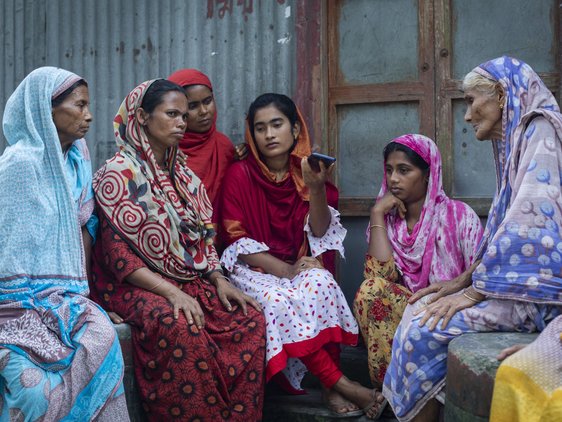
Women telling her family and neighbors of Bharatkhali Union of Gaibamdha about the flood warning from SUFAL project. © Jannatul Mawa
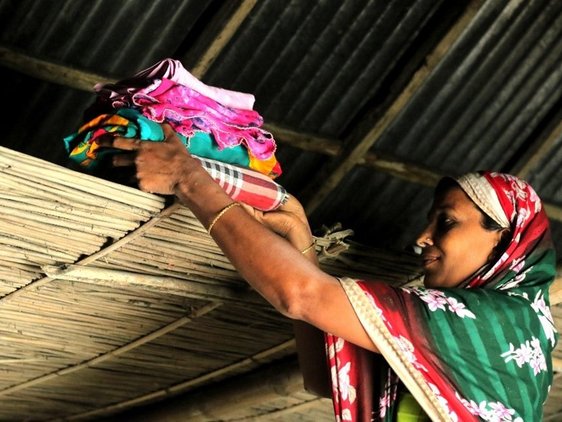
Women store items to prepare for a flood in Bangladesh. © Asafuzzaman / CARE Bangladesh
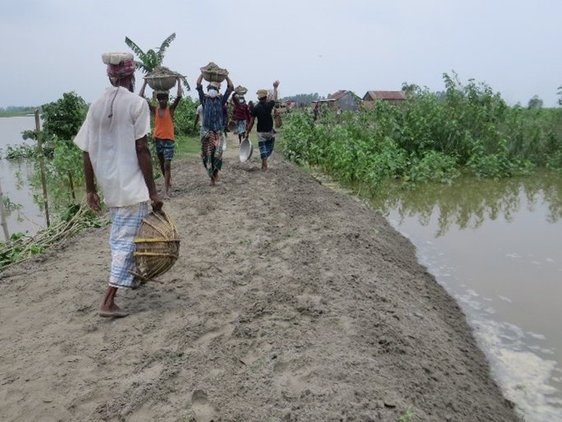
Repairs to an embankment in Islampur, Jamalpur, with co-financing from the local government administration and the SUFAL project. © Nazimuzzaman / Islamic Relief Bangladesh

Women telling her family and neighbors of Bharatkhali Union of Gaibamdha about the flood warning from SUFAL project. © Jannatul Mawa
Women store items to prepare for a flood in Bangladesh. © Asafuzzaman / CARE Bangladesh
Repairs to an embankment in Islampur, Jamalpur, with co-financing from the local government administration and the SUFAL project. © Nazimuzzaman / Islamic Relief Bangladesh
Further resources
- Video - Financing anticipatory action: SUFAL’s experience of tackling this from a localization perspective
- Video: Women in anticipatory action – experiences from forecast-based action for floods in Bangladesh
- Evaluation of Supporting flood Forecast-based Action and Learning (SUFAL) project in the 2020 monsoon floods
- Forecast-based financing in Bangladesh: scopes and challenges
- Institutionalizing forecast-based action: learning from FbA in northwest Bangladesh during the 2020 monsoon season
- Resilient Communities Acting Early to Mitigate Effects of 2020-21 Monsoon Floods in Bangladesh: Stories from the Frontline
- Supporting Flood Forecast-based Action and Learning in Bangladesh (SUFAL): project summary
- Linking Forecast-based Action to Social Safety Net Programmes in Bangladesh
- Options for Linking Forecast-based Action and Social Safety Net Programmes in Bangladesh
- Options for Linking Forecast-based Action and Social Safety Net Programmes in Bangladesh - Executive Summary
- Flood Forecast based Action - Development of Matrix and Triggers
- Short paper on localizing anticipatory action in Bangladesh
- Scaling up Forecast-based Action and Learning in Bangladesh - brief

